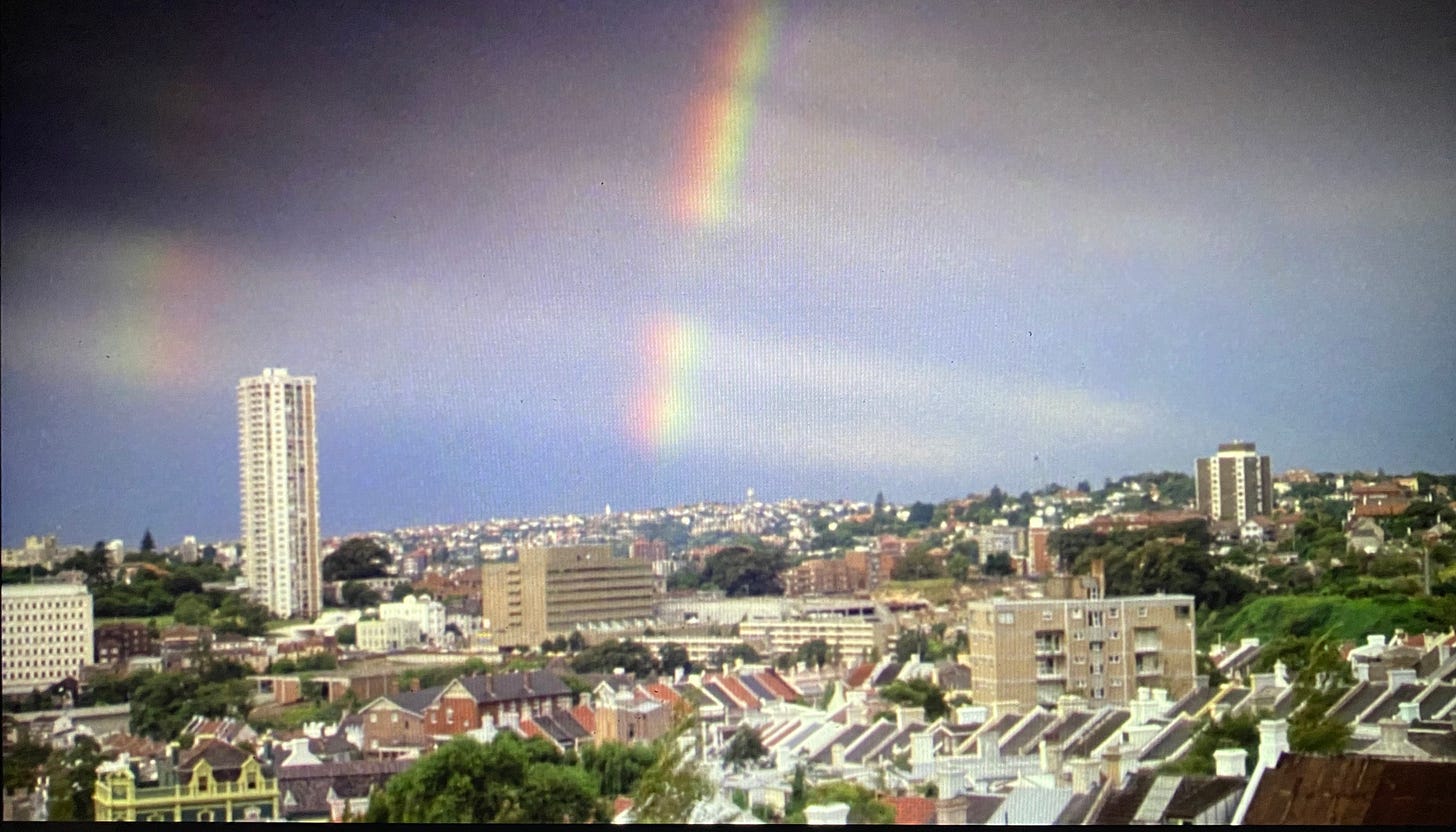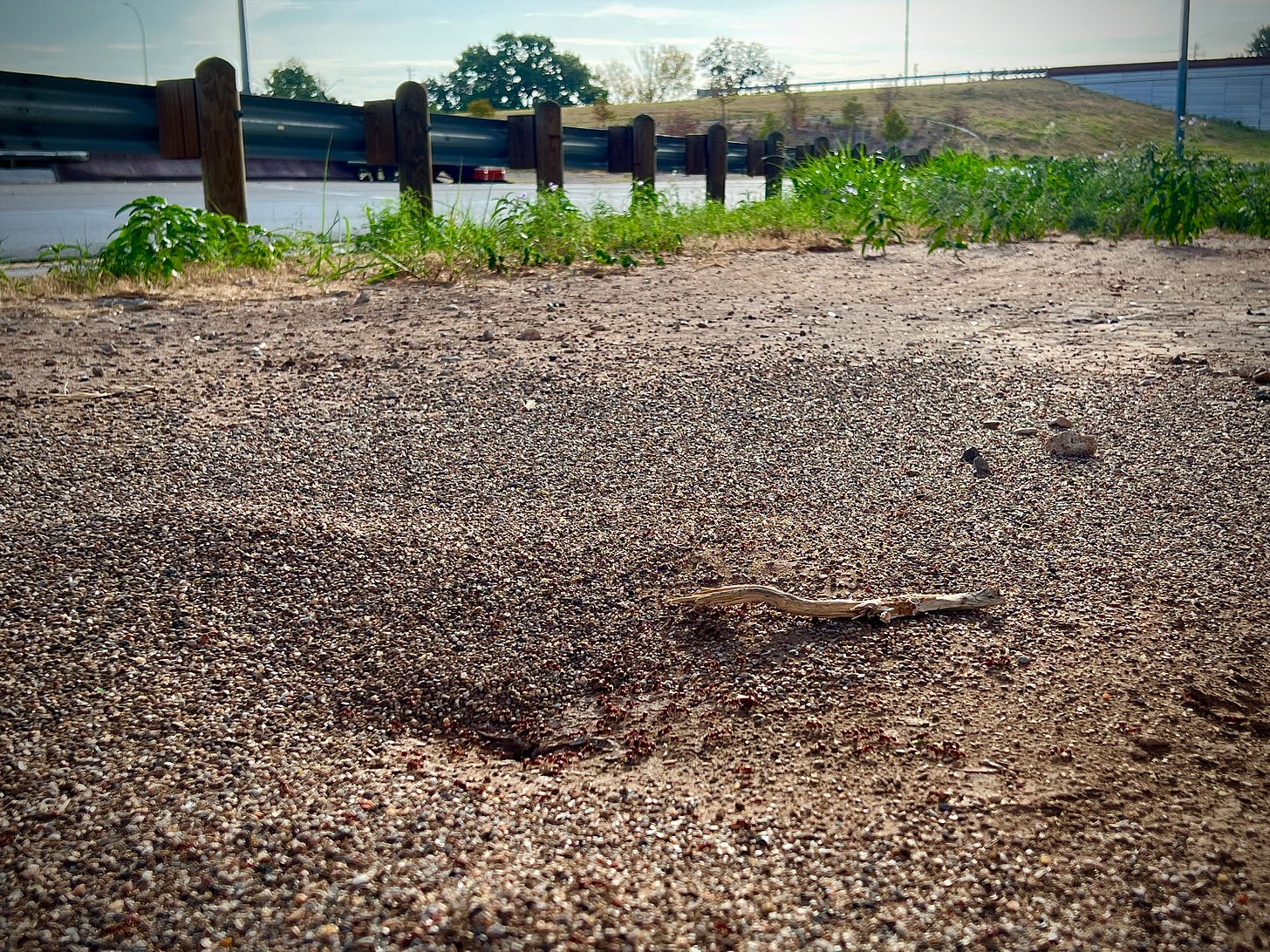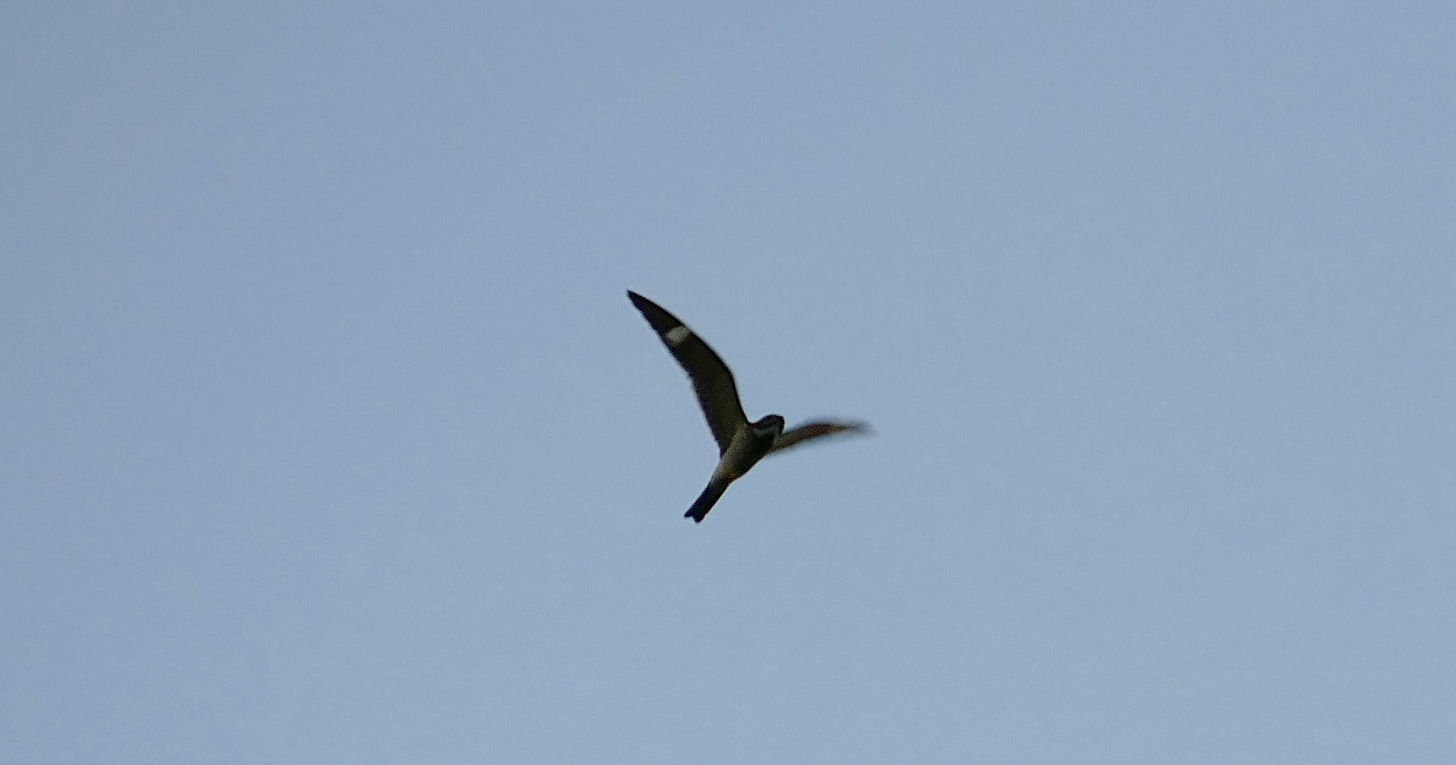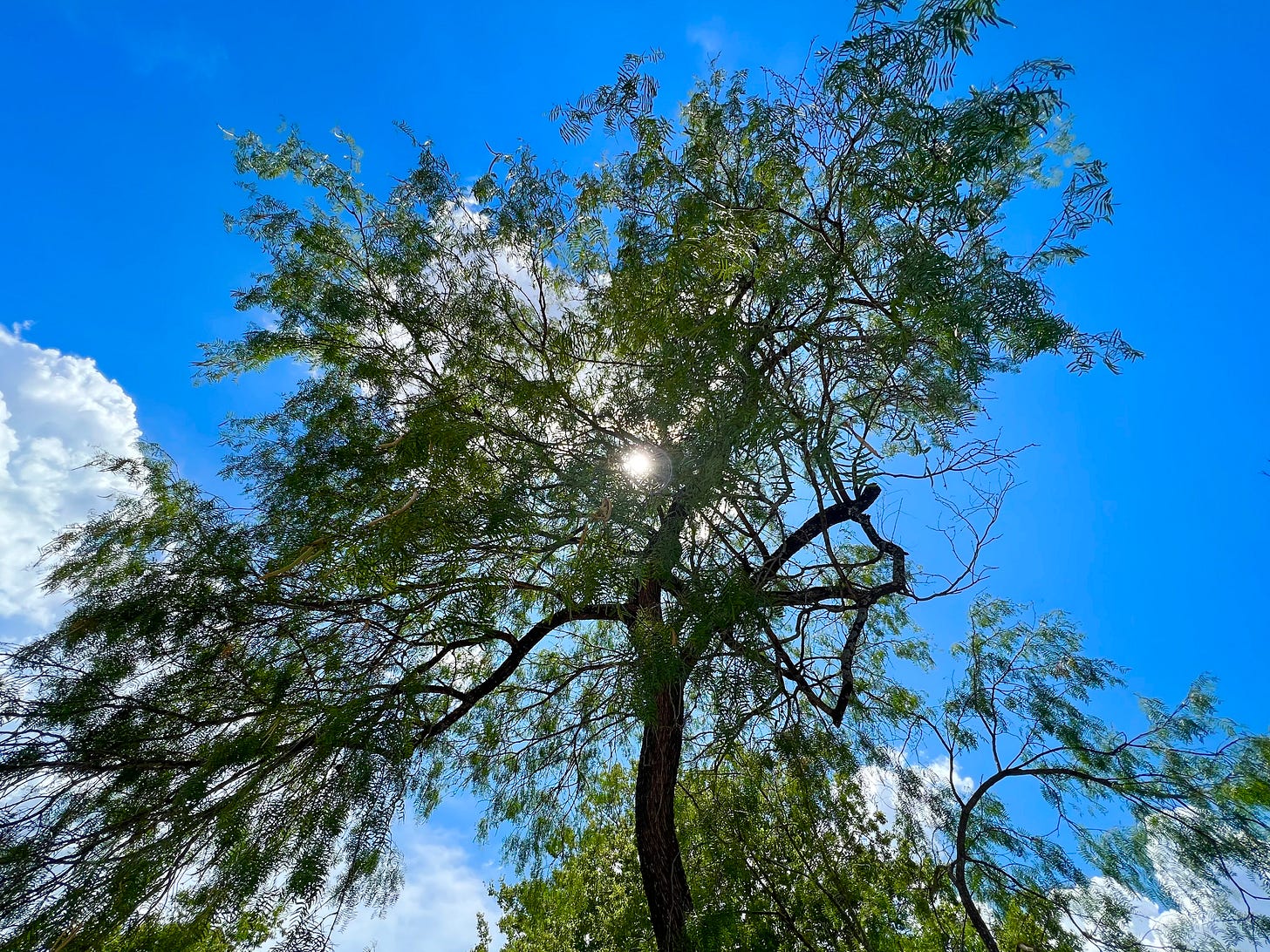The drought foragers
Wednesday afternoon I saw my first rainbow of this brutal summer. When I stepped out of my guitar teacher’s house in north Austin, it started raining, real rain, but by the time I got in my car it had already stopped. As I headed home on the elevated freeway that follows the trail the first Anglo settlers used to travel between the valley of the Colorado and the more rugged country of the Balcones Escarpment, the full arc of a rainbow was there to the northeast. You could see the big rain behind it, a storm that was probably twenty miles away. A rain that eludes you, and gets you thinking that when the rain finally comes, it will be the kind of rain that never stops.
Thinking about it later, I was reminded of one of the vignettes from The Last Wave, Peter Weir’s mystical 1977 eco-noir about a white Australian solicitor who accepts a court appointment to defend a group of aboriginals accused of murder, only to have the investigation of the case and the deep history buried under the city cause him to have increasingly vivid premonitions of the end of the world (or at least of the colonial capitalist society he loyally serves). There’s a key scene where the lawyer, played by Richard Chamberlain, is stuck in traffic and suddenly sees the cityscape around him submerged, people drowned and floating from their cars. In time, he becomes convinced that his waking dreams are accurate premonitions of what’s coming.
Wednesday morning when I went for my run, the harvester ants were out in massive convoys, hauling grain down the dirt highways they cleared in the offramp right of way. The foragers are dispatched from the colony in proportion to how quickly their fellow workers are returning with food, a method mathematically identical to TCP/IP. It was surprising to see the most active grain collection of the summer taking place on in the peak of a seemingly dead season, after more than two months of rainless triple-digit days. An affirming reminder of how much wild life a parched city can sustain from unlikely habitats, like the interstitial prairies of roadside weeds that feed the native ants that outlasted their main predator in the game of Anthropocene adaptation.
Similar signs can be seen all over the urban landscape, if you look for them. In just the past few weeks, the bats and nighthawks have been starting to come out early enough to really see them, hunting the bounty of insects that the river valley produces even in a dead summer. The sunflowers bloom all through the hottest months, somehow getting all the moisture they need from the cracked earth, providing prodigious seed for the birds who know.
The baseball-sized buffalo gourds appear in the medians, nestled under elephant ear leaves that sprout bright yellow flowers easily mistaken for zucchini blossoms. The mustang vines are thick with their deep purple grapes, staining the sidewalks where they fall from the fences, ready to be harvested for an intense wild wine. And beginning in midsummer, the tough mesquite trees that grow fast and gnarly in these parts begin to drop their bean-like seed pods.
You know the season has arrived when you begin to hear the chatter of the monk parakeets overhead, the call of the descendants of escaped pets who could learn to speak your language if you kept them in your home for a while. They come in loud gangs, hanging out on the high branches, breaking out the new seeds, and tossing the empty pods to the ground. Those pods are what the indigenous peoples of the Southwest liked to grind into a nutrient-rich flour. And there’s a lot of talk in ecologically savvy circles about making the bountiful food of that drought-tolerant tree into a more mainstream food source for contemporary inhabitants of the American desert.
The biggest mesquite tree in our yard is around seventy years old, with the rugged and unexpected lines of some giant edgeland bonsai. It grew in the right of way of a petroleum pipeline that once bisected this lot, and survived the long years when this place was an illegal dump site, and then the year when the guys who built our house half-buried it in dirt. The newest one that has grown to maturity appeared a few years ago, after we rewilded our front yard, and is more attentively groomed with pruning shears. Either one drops branches that can puncture a bike tire and sometimes a car tire.
The sweet nectar of its seed pods is fueled by roots that can reach 160 feet into the earth. A tree that can fruit on less than three inches of rain a year.
In Big Bend National Park this week, they had to clear out the campgrounds in the Chisos Basin because the bears had come down from the mountains en masse to collect the mesquite pods that were dropping there, not far from the lodge.
“Due to the abundance of mesquite beans in the campground, the bears have become territorial and shown signs of aggression.”
I read that news the same evening I began reading Richard Jefferies’ novel Wild London; or Wild England. It had been recommended to me by my friend the writer Howard Waldrop, who said he was reminded of it after hearing me read an excerpt at last weekend’s Armadillocon from the creative nonfiction book I have been working on with the same urban nature material as this newsletter. Howard is one of those writers whose recommendations one pays attention to, especially when he is saying nice things about your work, and I immediately tracked down the recently published critical edition from Edinburgh University Press that he specifically recommended. I expected the book, having originally been published in 1885, to read like a Victorian novel. But the voice proved as astonishingly contemporary as its vision of a rewilded civilization:
The old men say their fathers told them that soon after the fields were left to themselves a change began to be visible. It became green everywhere in the first spring, after London ended, so that all the country looked alike.
The meadows were green, and so was the rising wheat which had been sown, but which neither had nor would receive any further care. Such arable fields as had not been sown, but where the last stubble had been ploughed up, were overrun with couch-grass, and where the short stubble had not been ploughed, the weeds hid it. So that there was no place which was not more or less green; the footpaths were the greenest of all, for such is the nature of grass where it has once been trodden on, and by-and-by, as the summer came on, the former roads were thinly covered with the grass that had spread out from the margin.
When I finished the first chapter and put the book down, I got to thinking about the mesquite-eating bears.
Bears used to be plentiful all across Texas, and they are starting to show up more often at the edges of our most densely populated zones. Thursday night, as the full Sturgeon Moon rose over the eastern edge of town, somehow generating more light than all of the lamps of the city, I got to wondering whether, in time, they might clear out more than a campground. That kind of future feels like it wants to happen, after America.
Further reading
For more on the wild mesquite tree as food source for the future, check out this Chris Malloy piece at The Counter.
For more on the secrets of the Anternet, check out this June 2020 installment of Field Notes about the epic colony we had when we first moved here, or this Stanford University news report on the original research.
If you’re curious about sightings of black bears in Central Texas, this 2018 piece at The Hill Country is pretty interesting.
The Last Wave is streaming this month on The Criterion Channel, part of a curated collection of films featuring the indigenous Australian actor David Gulpilil, who is the film’s real star. This 2014 reconsideration of the film at The Guardian is a pretty good backgrounder.
The Old Farmer’s Almanac presumes to name the moons, including this week’s.
You can find some of Howard Waldrop’s best stories available online here, including one of my favorites, “Night of the Cooters,” which reimagines H.G. Wells’ War of the Worlds through a Texas prism, and “Mary Margaret Road-Grader,” a Waldropian take on the dream of Native Americans taking their land back.
For a longer read, the full text of After London is available for free online at Project Gutenberg.
Have a wild week.













Hi there. Loved this post. I saw The Last Wave years ago in an art theater, then again a few years ago. Also Picnic At Hanging Rick. Both mysteriously apocalyptic. Dream time. Jeff Nichols’s intense Take Shelter Is very similar to TLW.
Weir lost his weirdness after those two. But still made some great films afterwards. Waldrop’s The Ugly Chickens reminds me of the recent sighting of an ivory bill woodpecker again. You never know.
If you enjoyed After London, you might also like "A Scientific Romance" by Ronald Wright (best known from his nonfiction - "Short history of progress" and "Stolen Continents: The New World Through Indian Eyes") - its inspired by After London (and Well's Time Machine) - here's a brief review from internet - https://www.challengingdestiny.com/reviews/scientificromance.htm